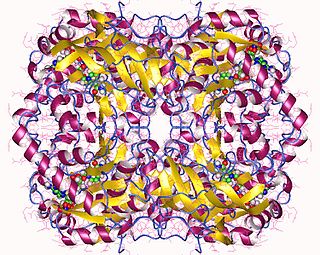
Sirolimus, also known as rapamycin and sold under the brand name Rapamune among others, is a macrolide compound that is used to coat coronary stents, prevent organ transplant rejection, treat a rare lung disease called lymphangioleiomyomatosis, and treat perivascular epithelioid cell tumour (PEComa). It has immunosuppressant functions in humans and is especially useful in preventing the rejection of kidney transplants. It is a mammalian target of rapamycin (mTOR) kinase inhibitor that reduces the sensitivity of T cells and B cells to interleukin-2 (IL-2), inhibiting their activity.

Streptomyces is the largest genus of Actinomycetota, and the type genus of the family Streptomycetaceae. Over 700 species of Streptomyces bacteria have been described. As with the other Actinomycetota, streptomycetes are gram-positive, and have very large genomes with high GC content. Found predominantly in soil and decaying vegetation, most streptomycetes produce spores, and are noted for their distinct "earthy" odor that results from production of a volatile metabolite, geosmin. Different strains of the same species may colonize very diverse environments.

Aminocoumarin is a class of antibiotics that act by an inhibition of the DNA gyrase enzyme involved in the cell division in bacteria. They are derived from Streptomyces species, whose best-known representative – Streptomyces coelicolor – was completely sequenced in 2002. The aminocoumarin antibiotics include:

Regulatory-associated protein of mTOR also known as raptor or KIAA1303 is an adapter protein that is encoded in humans by the RPTOR gene. Two mRNAs from the gene have been identified that encode proteins of 1335 and 1177 amino acids long.

Crotonyl-CoA carboxylase/reductase (EC 1.3.1.85, CCR, crotonyl-CoA reductase (carboxylating)) is an enzyme with systematic name (2S)-ethylmalonyl-CoA:NADP+ oxidoreductase (decarboxylating). This enzyme catalyses the following chemical reaction
L-lysine cyclodeaminase (EC 4.3.1.28, rapL (gene), fkbL (gene), tubZ (gene), visC (gene)) is an enzyme with systematic name L-lysine ammonia-lyase (cyclizing; ammonia-forming). This enzyme catalyses the following chemical reaction
Methanosaeta concilii is an archaeum in the disputed genus Methanosaeta. It is obligately anaerobic, gram-negative and non-motile. It is rod-shaped with flat ends. The cells are enclosed within a cross-striated sheath. The type strain is GP6. Its genome has been sequenced.
Streptomyces isolates have yielded the majority of human, animal, and agricultural antibiotics, as well as a number of fundamental chemotherapy medicines. Streptomyces is the largest antibiotic-producing genus of Actinomycetota, producing chemotherapy, antibacterial, antifungal, antiparasitic drugs, and immunosuppressants. Streptomyces isolates are typically initiated with the aerial hyphal formation from the mycelium.
Streptomyces cattleya is a Gram-positive bacterium which makes cephamycin, penicillin and thienamycin. The bacterium expresses a fluorinase enzyme, and the organism has been used to understand the biosynthesis of fluoroacetate and the antibacterial 4-fluoro-L-threonine. The γ-Glu-βes pathway to biosynthesis of non-traditional amino acids β-ethynylserine (βes) and L-propargylglycine (Pra) was first characterized in this species.
Streptomyces albulus is a bacterium species from the genus of Streptomyces. Streptomyces albulus produces acetoxycycloheximide, aciphenol, albanoursin and cycloheximide.
Streptomyces chartreusis is a bacterium species from the genus of Streptomyces which has been isolated from soil in Africa. Streptomyces chartreusis produces N-deacyltunicamycin, elsamicin A, aminoacylase and chartreusin.
Streptomyces exfoliatus is a bacterium species from the genus of Streptomyces which has been isolated from soil. Streptomyces exfoliatus has the ability to degrade poly(3-hydroxyalkanoate). This species produces exfoliatin and exfoliamycin.
Streptomyces fildesensis is a bacterium species from the genus of Streptomyces which has been isolated from antarctic soil.
Streptomyces griseorubens is a bacterium species from the genus of Streptomyces which has been isolated from soil. Streptomyces griseorubens produces althiomycin. Streptomyces griseorubens produces matamycin and althiomycin.
Streptomyces lydicus is a bacterium species from the genus of Streptomyces which has been isolated from soil in the United States. Streptomyces lydicus produces actithiazic acid, natamycin, lydimycin, streptolydigin, and 1-deoxygalactonojirimycin. Streptomyces lydicus can be used as an agent against fungal plant pathogens like Fusarium, Pythium, Phytophthora, Rhizoctonia and Verticillum.
Streptomyces mutabilis is a bacterium species from the genus of Streptomyces which has been isolated from soil. Streptomyces mutabilis produces the antibiotic mutalomycin. Streptomyces mutabilis UAE1 has been found to promote plant growth in gray mangroves under greenhouse conditions by producing polyamines putrescine (Put), spermidine (Spd), and spermine (Spm).
Streptomyces tsukubensis is a bacterium species from the genus of Streptomyces which has been isolated from soil in Ibaraki in Japan. Streptomyces tsukubensis produces the immunosuppressant tacrolimus.
Streptomyces viridosporus is a bacterium species from the genus of Streptomyces. Streptomyces viridosporus produces sistomycine and lignin peroxidase. Streptomyces viridosporus can degrade lignin and humic acids. Streptomyces viridosporus also produces moenomycin A, a component of bambermycin.
Streptomyces xinghaiensis is a bacterium species from the genus of Streptomyces which has been isolated from marine sediments from Xinghai Bay near Dalian in China.
Methylosinus trichosporium is an obligate aerobic and methane-oxidizing bacterium species from the genus of Methylosinus. Its native habitat is generally in the soil, but the bacteria has been isolated from fresh water sediments and groundwater as well. Because of this bacterium's ability to oxidize methane, M. trichosporium has been popular for identifying both the structure and function of enzymes involved with methane oxidation since it was first isolated in 1970 by Roger Whittenbury and colleagues. Since its discovery, M. trichosporium and its soluble monooxygenase enzyme have been studied in detail to see if the bacterium could help in bioremediation treatments.




